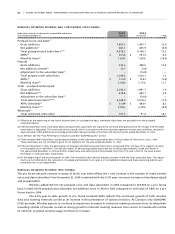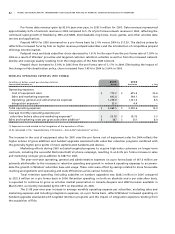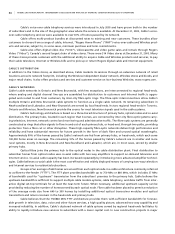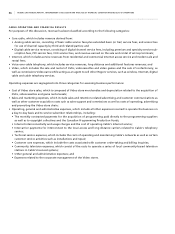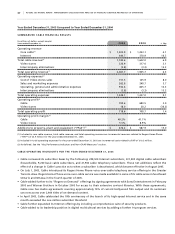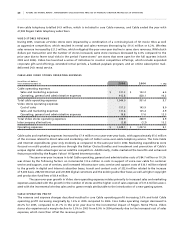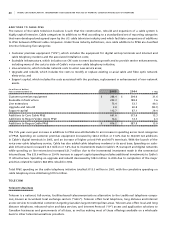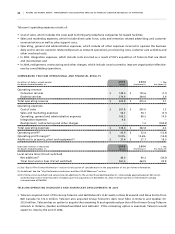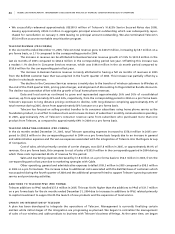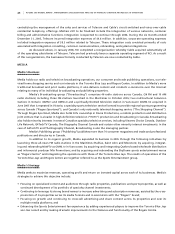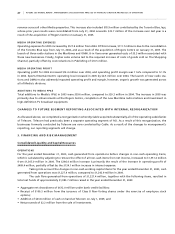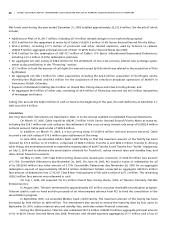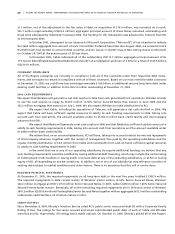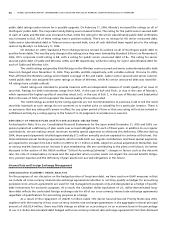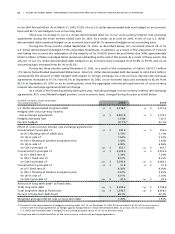Rogers 2005 Annual Report Download - page 45
Download and view the complete annual report
Please find page 45 of the 2005 Rogers annual report below. You can navigate through the pages in the report by either clicking on the pages listed below, or by using the keyword search tool below to find specific information within the annual report.
41 ROGERS 2005 ANNUAL REPORT . MANAGEMENT’S DISCUSSION AND ANALYSIS OF FINANCIAL CONDITION AND RESULTS OF OPERATIONS
Following our July 1, 2005 acquisition of Telecom, we began to centralize the management of our Wireless and
Cable business products with Telecom’s business offerings. At the same time, we began centralizing the management of
the sales and services of Telecom and Cable’s circuit-switched and voice-over-cable residential telephony offerings.
TE L E CO M ’S PR O D UC T S A ND S ER V IC E S
Telecom offers voice and data telecommunications services across Canada to residential customers, and to small, medium
and large businesses. Large businesses include financial institutions and national retailers as well as other large users of
telecommunications services, such as other communications companies and various levels of government. In the residen-
tial markets, Telecom focuses on offering customers bundled product solutions with all services on one bill, offering a
seamless communication solution from a single provider which increases both revenue per customer and total customer
life through reduced churn.
Telecom markets a full range of data and IP services, attractive to all business segments, for multi-site
connectivity, remote access to corporate information resources and Internet access. Value-added services such as man-
aged network services (“MNS”) and bundled applications such as video conferencing enable Telecom to tailor solutions
specifically to customers’ business needs. Telecom’s data services portfolio includes: traditional transport services such as
digital private line, frame relay and Asynchronous Transfer Mode (“ATM”); data services such as transparent LAN services
(“TLS”), IP virtual private networks (“IP VPN”) for remote access service and IP VPN for multi-site networks; and MNS such
as router management and reporting.
Telecom’s solutions in the business market offer several advantages: a single flexible network that encom-
passes a range of access types from various digital subscriber technologies (“xDSL”) to Ethernet allowing a customer
to tailor a solution to precisely match the requirements of each site; a migration path from legacy frame relay
services, which delivers more bandwidth, more flexibility and a platform for emerging converged IP applications; and an
opportunity to simplify customers’ data solutions, moving from disparate services to a single IP platform.
TE L E CO M ’S DI S T RI B UT I ON N ET W OR K
Telecom markets and sells its residential products and services across Canada through multiple distribution channels
including telemarketing, field agents, direct mail, television advertising, and affinities. It also markets and sells its ser-
vices through Wireless, Cable and Video and its products are included in product bundles together with Wireless and
Cable products. Telecom markets and sells its business products through a variety of channels including its own direct
sales force, exclusive and non-exclusive agents as well as through its business affinities and associations. Telecom also
offers products and services through the Rogers e-business website, www.rogers.com.
TE L E CO M ’S NE T W OR K
To provide local service, Telecom co-locates its equipment in the switch centres of the incumbent local exchange carriers
(“ILECs”). At December 31, 2005, Telecom was active in 160 co-locations in 36 municipalities in five of Canada’s most
populous metropolitan areas in and around Vancouver, Calgary, Toronto, Ottawa, and Montreal. Many of these co-
locations are connected to Telecom’s local switches by metro area fibre networks (“MANs”). In addition to operating a
national IP network in Canada, Telecom operates a North American transcontinental fibre optic network extending over
16,000 route kilometres (10,000 route miles) providing a significant North American geographic footprint connecting
Canada’s largest markets while also reaching key U.S. markets. In Canada, the network extends from Vancouver in the
West to Québec City in the East. Telecom is also in the process of acquiring various of the Competitive Local Exchange
Carrier (“CLEC”) assets of GT/360 from Bell Canada, providing it with the option to purchase the majority of such assets in
Ontario, Québec, and Newfoundland and Telecom has already exercised its option for New Brunswick and Nova Scotia
assets during the year. The assets include local and long-haul fibre, transmission electronics and systems, GT’s hubs, points
of presence (“POPs”) and ILEC co-locations, and switching infrastructure. Telecom’s network extends into the U.S. from
Vancouver south to Seattle in the West, from the Manitoba-Minnesota border, through Minneapolis, Milwaukee and
Chicago in the mid-West and from Toronto through Buffalo and Montréal through Albany to New York City in the East.
Telecom also has connected its North American network with Europe through international gateway switches in New York
City, London and a leased trans-Atlantic fibre facility.
Telecom has installed switching technology and advanced fibre optic cable and electronic equipment offering
dense wave division multiplexing (“DWDM”) and synchronous optical network (“SONET”) ring protection, and also has
an advanced network management system that gives it the ability to monitor network performance, access and utilization.
Telecom’s fibre optic network features physical route diversity with SONET protection thereby offering superior security


